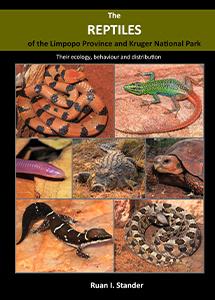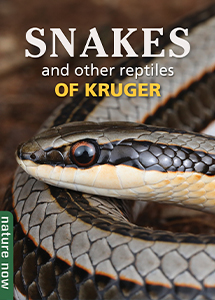Description
The Reptiles of the Limpopo Province and the Kruger National Park
Author: Stander
Format: Paperback
Published: October 2023
Worm or lizard? Legless sking or snake – actually, what’s a skink? Reptiles come in a dazzling array of shapes, sizes and colours.
The Kruger National Park is home to 125 of South Africa’s 434 species. All exept six of these living gems also occur in the Limpopo Province from which a staggering total of 204 species are known. The region boasts the highest reptile diversity in South Africa – half or the country’s herpetofauna occours here and more than 40 species are endemic. Several are newly described and have never been pictured in a popular field guide, while many have undergone significatn taxonomic revision. This volume is packed with first hand information and brings the region’s 210 species and their habitats to life with more than 600 photographs. This book is an indispensable resource for any serious African herpetologist, ecologist, nature guide, game ranger and hunter. Nevertheless is is purposefully crafted to offer a gateway into the fascinating world of reptiles for enthusiasts, budding naturalists and the youth.
- Includes family and genus accounts
- Detailed overview of the region’s biogeography, habitats and centres of endemism.
- Field notes supplemented with the latest research.
- Exhaustive bibliography (nearly 500 entries)
- Author citation and type locality provided for each species.
- Indigenous-language common names for all species, in four languages-a first for an African reptile field guide.
- Colour-coded provincial and country-scale distribution maps.
Foreword by Johan Marais:
“Several books are now available on the snakes of South Africa, some older books on crocodiles, and tortoises and chameleons have received some good attention. But with close on 440 reptile species in South Africa, very little has been published about reptiles other than snakes.
Limpopo and the Kruger National Park are home to close on half of our reptile species, which are found in a wide variety of habitats. While the snakes of Limpopo and the Kruger National Park have had some good coverage in recent snake books, little has been published about the lizards, tortoises, terrapins and even the Nile crocodile.
Ruan Stander is a reptile enthusiast who has spent much of his life in Limpopo. He has spent many years collecting information, not just about the reptiles of Limpopo and the Kruger National Park but also its biodiversity, and three years were spent doing active field research. He is also a keen photographer with a particular interest in photographing reptiles and frogs, and most of the photographs in the book were taken by him.
After many years of studying reptiles and seeing how natural areas were being destroyed, reptiles killed on roads or by ignorant people, and others being poached for the illegal pet trade, he decided to put together a book on the reptiles of Limpopo and the Kruger National Park. His objective was to compile a book that would enable people to learn more about the reptiles of the region, to understand not just them but also the environment in which they are found, to assist in their conservation and, of course, a book that serious enthusiasts and professionals could use as a reference work.
I am highly impressed with the amount of detail that Ruan has put into this publication. The introductory chapters on reptile biology and behaviour, anatomy, and taxonomy as well as extensive chapters on geography will aid both the enthusiasts and professionals.
The species accounts of 210 reptiles are comprehensive with his own observations and information from the published literature, vernacular names in various African languages, detailed distribution maps and an abundance of colour photographs. Over 600 colour photographs were used in this 367-page book.
This book is a valuable contribution to our current herpetological knowledge, especially for Limpopo and the Kruger National Park, and will appeal to a wide range of readers from farmers to students, wildlife enthusiasts and conservationists as well as professional herpetologists.”





Reviews
There are no reviews yet.